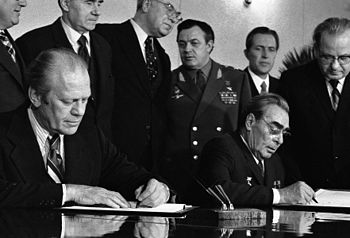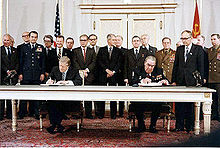- Strategic Arms Limitation Talks
-
 Gerald Ford and Leonid Brezhnev signing a joint communiqué on the SALT treaty in Vladivostok, November 23, 1974
Gerald Ford and Leonid Brezhnev signing a joint communiqué on the SALT treaty in Vladivostok, November 23, 1974
The Strategic Arms Limitation Treaty refers to two rounds of bilateral talks and corresponding international treaties involving the United States and the Soviet Union—the Cold War superpowers—on the issue of armament control. There were two rounds of talks and agreements: SALT I and SALT II.
Negotiations commenced in Helsinki, Finland, in 1969. SALT I led to the Anti-Ballistic Missile Treaty and an interim agreement between the two powers. Although SALT II resulted in an agreement in 1979, the United States chose not to ratify the treaty in response to the Soviet invasion of Afghanistan, which took place later that year. The US eventually withdrew from SALT II in 1986.
The treaties then led to START (Strategic Arms Reduction Treaty), which consisted of START I (a 1991 agreement between the United States, the Soviet Union) and START II (a 1993 agreement between the United States and Russia). These placed specific caps on each side's number of nuclear weapons.
Contents
SALT I
SALT I is the common name for the Strategic Arms Limitation Talks Agreement, also known as Strategic Arms limitation Treaty. SALT I froze the number of strategic ballistic missile launchers at existing levels, and provided for the addition of new submarine-launched ballistic missile (SLBM) launchers only after the same number of older intercontinental ballistic missile (ICBM) and SLBM launchers had been dismantled.
The strategic nuclear forces niche of the Soviet Union and the United States was changing in character in 1968. The U.S.'s total number of missiles had been static since 1967 at 1,054 ICBMs and 656 SLBMs, but there was an increasing number of missiles with multiple independently targetable reentry vehicle (MIRV) warheads being deployed. MIRV's carried multiple nuclear warheads, often with dummies, to confuse ABM systems, making MIRV defense by ABM systems increasingly difficult and expensive. One clause of the treaty required both countries to limit the number of sites protected by an anti-ballistic missile (ABM) system to two each. The Soviet Union had deployed such a system around Moscow in 1966 and the United States announced an ABM program to protect twelve ICBM sites in 1967. A modified two-tier Moscow ABM system is still used. The U.S. built only one ABM site to protect Minuteman base in North Dakota where the "Safeguard Program" was deployed. Due to the system's expense and limited effectiveness, the Pentagon disbanded "Safeguard" in 1975.
Negotiations lasted from November 17, 1969, until May 1972 in a series of meetings beginning in Helsinki, with the U.S. delegation headed by Gerard C. Smith, director of the Arms Control and Disarmament Agency. Subsequent sessions alternated between Vienna and Helsinki. After a long deadlock, the first results of SALT I came in May 1971, when an agreement was reached over ABM systems. Further discussion brought the negotiations to an end on May 26, 1972, in Moscow when Richard Nixon and Leonid Brezhnev signed both the Anti-Ballistic Missile Treaty and the Interim Agreement Between The United States of America and The Union of Soviet Socialist Republics on Certain Measures With Respect to the Limitation of Strategic Offensive Arms.[1] A number of agreed statements were also made. This helped improve relations between the U.S. and the USSR.
SALT II
SALT II was a controversial experiment of negotiations between Jimmy Carter and Leonid Brezhnev from 1977 to 1979 between the U.S. and the Soviet Union, which sought to curtail the manufacture of strategic nuclear weapons. It was a continuation of the progress made during the SALT I talks, led by representatives from both countries. SALT II was the first nuclear arms treaty which assumed real reductions in strategic forces to 2,250 of all categories of delivery vehicles on both sides. SALT II helped the U.S. to discourage the Soviets from arming their third generation ICBMs of SS-17, SS-19 and SS-18 types with many more Multiple independently targetable reentry vehicles (MIRVs). In the late 1970s the USSR's missile design bureaus had developed experimental versions of these missiles equipped with anywhere from 10 to 38 thermonuclear warheads each. Additionally, the Soviets secretly agreed to reduce Tu-22M production to thirty aircraft per year and not to give them an intercontinental range. It was particularly important for the US to limit Soviet efforts in the Intermediate-Range Nuclear Forces (INF) rearmament area. The SALT II Treaty banned new missile programs (a new missile defined as one with any key parameter 5% better than in currently deployed missiles), so both sides were forced to limit their new strategic missile types development. However, the US preserved their most essential programs like Trident and cruise missiles, which President Carter wished to use as his main defensive weapon as they were too slow to have first strike capability. In return, the USSR could exclusively retain 308 of its so-called "heavy ICBM" launchers of the SS-18 type.
An agreement to limit strategic launchers was reached in Vienna on June 18, 1979, and was signed by Leonid Brezhnev and President of the United States Jimmy Carter. In response to the refusal of the United States Senate to ratify the treaty, a young member of the Senate Foreign Relations Committee, Senator Joseph Biden of Delaware, met with the Soviet Foreign Minister Andrey Gromyko, "educated him about American concerns and interests" and secured several changes that neither the U.S. Secretary of State nor President Jimmy Carter could obtain.
Six months after the signing, the Soviet Union invaded Afghanistan, and in September of the same year, the Soviet combat brigade deployed to Cuba was discovered. In light of these developments, the treaty was never formally ratified by the United States Senate. Its terms were, nonetheless, honored by both sides until 1986 when the Reagan Administration withdrew from SALT II after accusing the Soviets of violating the pact.
Subsequent discussions took place under the Strategic Arms Reduction Treaty (START) and the Comprehensive Nuclear-Test-Ban Treaty.
See also
- Comprehensive Test Ban Treaty
- Intermediate-Range Nuclear Forces Treaty
- Measures to Further Reduction and Limitation of Strategic Offensive Arms
- Nuclear Non-Proliferation Treaty
- START
- Threshold Test Ban Treaty
References
External links
- Text of SALT I
- Text of SALT II
- Text of SALT II (cont.)
- Text of the treaty from the U.S. Department of State
- NuclearFiles.org Text of SALT II 1979
- Arms Control Today: U.S.-Soviet/Russian Nuclear Arms Control, June 2002.
- Annotated bibliography on the SALT treaties from the Alsos Digital Library
Nuclear weapons limitation treaties 1963 Partial Nuclear Test Ban Treaty · 1968 Nuclear Non-Proliferation Treaty · 1972 Anti-Ballistic Missile Treaty · 1974 Threshold Test Ban Treaty · 1970s Strategic Arms Limitation Talks · 1987 Intermediate-Range Nuclear Forces Treaty · 1991 START I · 1993 START II · 1994 United States – Russia mutual detargeting · 1996 Comprehensive Nuclear-Test-Ban Treaty (not into force) · 1997 START III · 2002 Strategic Offensive Reductions Treaty · 2010 New STARTCategories:- Cold War treaties
- Arms control treaties
- Nuclear weapons of the United States
- Nuclear weapons program of the Soviet Union
- History of the Soviet Union and Soviet Russia
- Soviet Union–United States relations
- Treaties of the Soviet Union
- Treaties of the United States
- History of the United States (1964–1980)
- Nuclear weapons governance
- Soviet Union–United States diplomatic conferences
- Diplomatic conferences in Finland
- Diplomatic conferences in Austria
- 1970 in international relations
Wikimedia Foundation. 2010.

